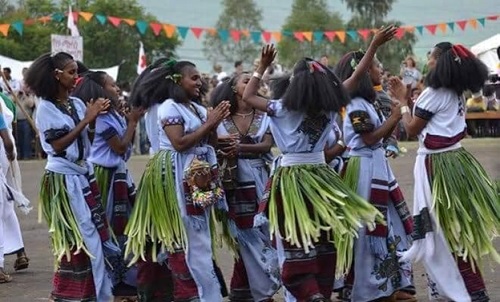
The Ashenda festival in Tigray has become a vibrant cultural celebration that honors young women and the Virgin Mary. Traditionally celebrated in August, Ashenda marks the end of the fasting period known as Filseta, commemorating the Assumption of Mary. The festival is named after the tall, elegant grass (Ashenda) that girls wear as skirts during the festivities. Girls and young women gather in colorful traditional dresses, adorned with jewelry, singing and dancing through the streets in groups.
Ashenda highlights the beauty, grace, and strength of Tigray women, with communities coming together to celebrate their vital role in the society. The joyful atmosphere is enriched by music, laughter, and community gatherings. The festival also serves as a platform for female empowerment, offering young women a space to express their cultural pride and solidarity. Ashenda is a cherished cultural event that blends religious devotion with social celebration in Tigray state.
Ashenda means the “tall green grass” estimated to be around 80–90 centimeters with a minimum height that girls wear it around their waists during playing on the holiday.
According to sources, in the northern part of Ethiopia, divided into groups, primed girls eagerly look forward to this cultural play on the eve of the sunny season. Following the heavy rain of the summer season (Kiremet) the grasses profusely grow longer and longer. This grass has great value for those girls waiting for the actual day of the Ashenda ceremonial event. They unplug these long grasses from their surrounding and make a miniskirt out of them. Doing so is not the girls’ final objective. Gathering in groups and going out into the streets, they stage different traditional dances chanting heart-titillating songs and beating a special drum with their hands. This as well is not their ultimate goal. Rather they dream beyond the game, facilitating good interactions with their peers. As they go out at their best they lure the opposite sex, with peeled eyes who are alert to choose their best. In most cases, the girls win suitors.
Ashenda in Tigray is a cultural festival for women. It is celebrated yearly from mid-August to the end of the month. Nowadays, this public festival has become a prominent cultural manifestation of residents of the locality. They mark the week-long holiday giving it special consideration as well as getting themselves ready ahead of time. The ceremonial occasion serves quite a role in cementing the relationship and ties of the society getting involved. Also, it helps to bequeath this intangible heritage to the coming generations.
Ashenda is an all-embracing participatory public festival in Tigray when the rainy season is due to end. More often it is usually played by females. But most of the time males also participate in the ceremony as admirers of the play and as bodyguards to the ladies. The fete has no age limit. Making a group of 5 up to 20, children also take part. The group criteria are based on friendship and neighborliness, among others.
After readying themselves and finalizing the required prerequisites needed for the ceremony, the ladies convene and sing together revealing their happiness and gratitude to those that offer them a gift on their way.
Recently, during this year’s Ashenda festival celebration in Mekelle Tigray State Chief Administrator Getachew Reda said that the annual colorful celebration of the festival significantly contributes to inheriting the state’s cultural and social assets to the future generations.
As to him, the prevailing peace in the state enables him to celebrate the festival colorfully in different parts of the state.
On his part, State Tourism and Culture Bureau Head Atsibeha Gebre Egziabher (PhD) said that the Ashenda girls are contributing significantly to inheriting the social and cultural values of the festival to future generations without losing its values.
So far, ensuring sustainable peace enables celebrating the festival together, he added.
Moreover, other tourism experts also witnessed that Ashenda is among the top street festivals in Ethiopia. It is one of the intangible cultural heritages celebrated annually at the end of the rainy season.
Tourism experts said that the annual celebration of the festival is gaining better attention among the public following the effective awareness of own cultural assets.
Currently, children are also actively participating in such festival celebrations. In doing so, the new generation is contributing its part to the restoration of ancient tangible and intangible heritages. In the past few years, there has been some sort of negligence to own cultural values following the growing influence of globalization.
Accordingly, such festivals have greater tourism potential and will have significant contributions to creating numerous job opportunities. The annual celebration of Ashenda lasts up to a week and enables tourist service providers to promote their services effectively. Currently, this public festival has become the prominent manifestation of the society in the area. They celebrate it giving cordial and special consideration as well as preparation that takes a longer time. The ceremonial occasion is building the relationship and ties of the society being involved mutually to keep the culture be inherited to grandchildren and future generations.
This cultural and religious festival contributes a lot to the manifestation of society and plays its role in strengthening societal ties and mutual coordination beyond sharing cultural values.
Moreover, celebrating such age-old festivals has a tremendous significance to society. It boosts the mutual relationship of the community. It plays a huge role in manifesting the socio-economic, cultural, political, psychological, and other aspects of the community. Due to this, it is gaining due attention year after year.
Accordingly, it is necessary to underpin those cultural festivals being celebrated worldwide and nationwide is the main colors of the society owning that culture. This cultural ceremony’s role is fundamental to boosting societal interaction and oneness under its umbrella. Eroding of the actual ceremonial process might kill the mutual pleasure that happens while convening together.
In sum, it needs to be alert to withstand the problem globalization poses on our culture and traditional assets. Everyone must engage in retrieving and keeping his/her own culture. Everyone else as much as owners of the heritages, has a greater responsibility of preserving the traditional assets worthy of inheritance to future generations.
BY TEWODROS KASSA
THE ETHIOPIAN HERALD FRIDAY 30 AUGUST 2024





